Beach Comfort |
|||||||||||||||||||||||||||||||||||||||||||||||||||||||
 |
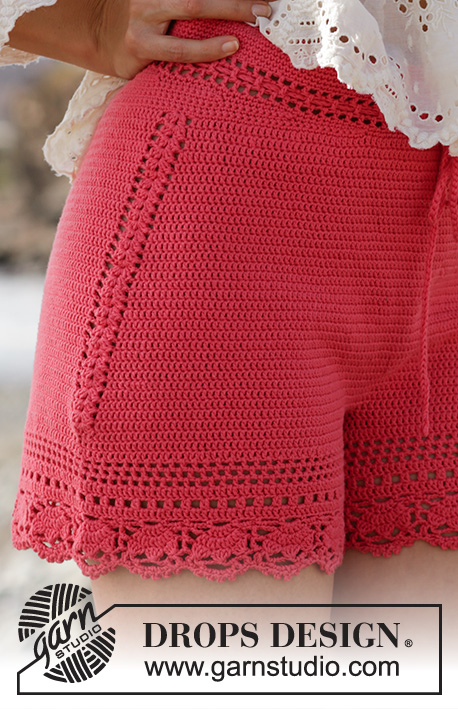 |
||||||||||||||||||||||||||||||||||||||||||||||||||||||
Crocheted shorts with lace pattern. Size: S - XXXL Piece is crocheted in DROPS Safran.
DROPS 190-25 |
|||||||||||||||||||||||||||||||||||||||||||||||||||||||
|
INFORMATION FOR PATTERN: PATTERN: See diagrams A.1 to A.5. CROCHET INFORMATION: On every round with single crochets replace first single crochet with 1 chain stitch. Finish round with 1 slip stitch in 1st chain stitch from beginning of round. At beginning of every round with double crochets replace first double crochet with 3 chain stitches. Finish round with 1 slip stitch in 3rd chain stitch from beginning of round. INCREASE TIP-1 (applies to sides): Work until 1 double crochet remains before A.2, work 2 double crochets in next double crochet, work A.2 and 2 double crochets in next double crochet (= 2 double crochets increased). Repeat in the other side (= 4 double crochets increased on round). INCREASE TIP-2 (applies to mid back): Increase 2 double crochets as follows: Work until 2 double crochets remain before marker, work 2 double crochets in first double crochet, 1 double crochet in each of the next 2 double crochets (marker is in the middle of these double crochets) and 2 double crochets in next double crochet (= 2 double crochets increased). Increase 4 double crochets as follows: Work until 4 double crochets remain before marker, work 2 double crochets in first double crochet, 1 double crochet in next double crochet, 2 double crochets in next double crochet, 1 double crochet in each of the next 2 double crochets (marker is in the middle of these double crochets) and 2 double crochets in next double crochet, 1 double crochet in next double crochet, 2 double crochets in next double crochet (= 4 double crochets increased). INCREASE TIP-3: Increase 1 double crochet by working 2 double crochets in same stitch. ---------------------------------------------------------- SHORTS: Work in the round top down. Work 244-274-299-329-369-404 chain stitches with Safran on hook size 2.5 mm and form a ring with 1 slip stitch in first chain stitch. Insert 1 marker thread at beginning of round = mid back. Work first round as follows: Work 1 chain stitch (= 1 single crochet) - read CROCHET INFO, 1 single crochet in each of the first 3 chain stitches, * skip 1 chain stitch, 1 single crochet in each of the next 4 chain stitches *, work from *-* 48-54-59-65-73-80 times in total = 196-220-240-264-296-324 single crochets. Then work 1 single crochet in every single crochet until piece measures 2 cm / ¾". REMEMBER THE CROCHET GAUGE! Now work in the round according to diagram A.1 as follows: Work A.1a (shows how rounds begin and end and is worked in addition to A.1b), work A.1b 49-55-60-66-74-81 times in total in width. Continue until A.1a/b have been worked vertically. Then work the shorts higher in the back as follows: Work 10-11-12-13-14-15 single crochets past the marker thread mid back, turn and work 1 slip stitch in first stitch, then 1 single crochet in each of the next 19-21-23-25-27-29 single crochets, turn and work 1 slip stitch in first stitch, then 1 single crochet in each of the next 29-31-35-38-41-44 stitches (slip stitches are also worked). Continue like this by working 10-11-12-13-14-15 stitches more on every turn until a total of 140-154-192-208-224-240 stitches have been worked. Turn again and work until marker thread mid back. Now work in the round as follows: Work 1 double crochet in each of the first 47-53-58-64-72-79 stitches (= half back piece), A.2 over the next 5 single crochets (= the side), work 1 double crochet in each of the next 92-104-114-126-142-156 stitches (= front piece), A.2 over the next 5 single crochets (= the side), work 1 double crochet in each of the last 47-53-58-64-72-79 stitches (= half back piece). Continue pattern like this (then repeat last round in A.2) - AT THE SAME TIME increase in the sides and mid back as follows: SIDES: Increase on each side of A.1, in each side as follows - read INCREASE TIP-1! Increase like this every 3rd-4th-4th-4th-4th-4th round 9-8-8-9-9-10 times in total (= 36-32-32-36-36-40 double crochets increased). MID BACK: When piece measures 15-16-17-19-20-22 cm / 5⅞"-6 ¼"-6⅝"-7⅜"-7⅞"-8⅝" (measured mid front), increase mid back as follows – read INCREASE TIP-2. Increase like this with 2 double crochets mid back on every round 4-8-10-10-10-10 times in total, then increase 4 double crochets on every round 5-3-3-3-3-3 times in total (= 28-28-28-32-32-32 double crochets increased). When all increases are done there are 260-280-300-332-364-396 double crochets on round. Continue with 1 double crochet in every double crochet until piece measures 22-24-26-28-30-32 cm / 8⅝"-9⅜"-10 ¼"-11"-11 ¾"-12 ½" mid front and 26-28-31-33-35-37 cm / 10 ¼"-11"-12⅛"-13"-13 ¾"-14 ½" mid back. Now divide for legs as follows: Work 1 slip stitch in each of the first 5-5-6-6-6-7 double crochets on round, turn and work back over the first 10-10-12-12-12-14 double crochets (i.e. 5-5-6-6-6-7 double crochets on each side of marker thread mid back). These 10-10-12-12-12-14 double crochets = gusset. Work double crochets back and forth over these double crochets for 10-11-12-13-14-15 cm / 4"-4⅜"-4¾"-5⅛"-5½-6", cut the thread. Fasten gusset edge to edge to the middle 10-10-12-12-12-14 stitches towards mid front. Then work leg. LEG: Work 1 double crochet in each of the 115-125-133-149-165-179 double crochets around one leg, work in addition A.3 (= 7 double crochets) over A.2 and work 26-28-32-34-36-38 double crochet along gusset = 148-160-172-190-208-224 double crochets. Then work 2-2-3-3-4-4 rounds with double crochets - on last round increase 8-8-8-2-8-4 double crochets evenly – read INCREASE TIP-3 = 156-168-180-192-216-228 double crochets. Now work in the round according to diagram A.4 as follows: Work A.4a (shows how rounds begin and end and is worked in addition to A.4b/c), work A.4b 77-83-89-95-107-113 times in total, A.1d. Continue until A.4a/b/c are done vertically = 156-168-180-192-216-228 double crochets. Now work in the round according to diagram A.5 as follows: Work A.5a (shows how rounds begin and end and is worked in addition to A.5b/c), A.5b, A.5c 12-13-14-15-17-18 times in total, and A.5d. Continue until A.5a/b/c/d have been worked vertically. Fasten off. Work the other leg the same way. TIE RIBBON: Work 120-140-150-160-170-180 cm / 47 ¼"-55⅛"-59"-63"-66⅞"-70⅞" with LOOSE chain stitches, turn and work 1 slip stitch in every chain stitch. Thread the tie in the middle row with eyelet holes at the top of shorts – start mid front. |
|||||||||||||||||||||||||||||||||||||||||||||||||||||||
Diagram explanations |
|||||||||||||||||||||||||||||||||||||||||||||||||||||||
|
|||||||||||||||||||||||||||||||||||||||||||||||||||||||
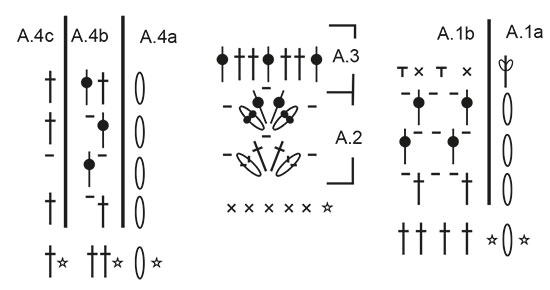
|
|||||||||||||||||||||||||||||||||||||||||||||||||||||||

|
|||||||||||||||||||||||||||||||||||||||||||||||||||||||
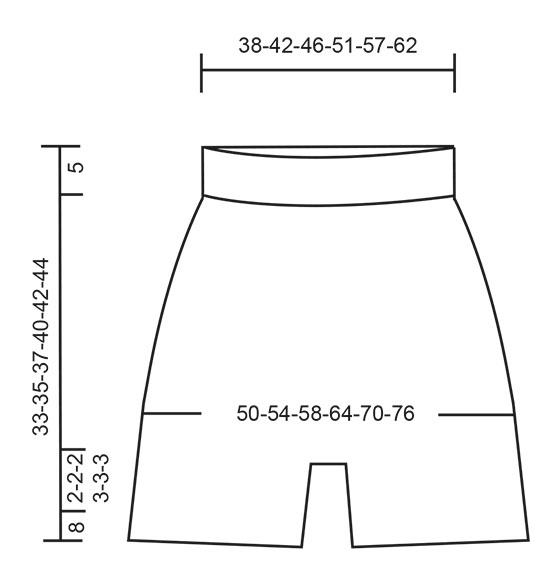
|
|||||||||||||||||||||||||||||||||||||||||||||||||||||||
|
Have you made this or any other of our designs? Tag your pictures in social media with #dropsdesign so we can see them! Do you need help with this pattern?You'll find tutorial videos, a Comments/Questions area and more by visiting the pattern on garnstudio.com. © 1982-2024 DROPS Design A/S. We reserve all rights. This document, including all its sub-sections, has copyrights. Read more about what you can do with our patterns at the bottom of each pattern on our site. |
|||||||||||||||||||||||||||||||||||||||||||||||||||||||








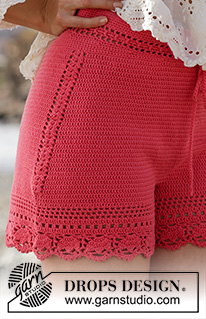






















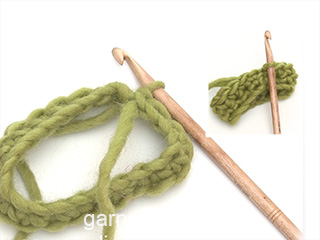


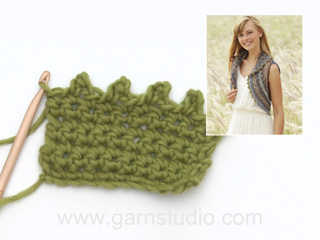





























Comments / Questions (49)
Thank you, Anjana! I read that chart the exact same way. Should it maybe be an x in place of the small oval in row five of chart A5?
28.06.2021 - 02:32DROPS Design answered:
Dear Allene, diagram is correct as it is, on row 5 crochet A.5 (= 4 chains), 1 tr in the 4th ch from previous row, 2 tr in next 2 tr, 2 chains (small oval) (= A.5b), then work: 1 tr around the 2-ch on previous row, 2 ch, 2 tr in each of the next 5 tr, 2 ch (= A.5c), 1 tr around the next 2 -ch-space, 2 ch, 2 tr in each of the next 2 tr, 1 tr in the 4th ch from beg of previous round (= A.5d). Hope this will help. Happy crocheting!
28.06.2021 - 07:48Ik begrijp de zesde/ zevende zin van de pijp niet. Er staat Haak A.4b 77-83-89-95-107-113 keer in totaal , A1 d. Dat A1 d hoort niet bij een patroon en ik begrijp niet wat er bedoeld wordt.
19.06.2021 - 22:41DROPS Design answered:
Dag Gea,
Dit is vermoedelijk een typefout, het moet waarschijnlijk A.4c zijn en niet A.1d. Ik zal het doorgeven aan de ontwerpafdeling ter correctie.
20.06.2021 - 12:19Ciao! Scusate ma non riesco a capire, probabilmente sono tonta io .. comunque dovrei iniziare ad aumentare sul dietro ma lo schema dice "lavorare fino a quando rimangono 2 maglie alte prima del segno..ecc" ma quale segno?si inizia ogni giro con 3 catenelle , quando e dove dovrei mettere qst segno?grazie 1000
14.06.2021 - 21:19DROPS Design answered:
Buonasera Valentina, il segno è il segnapunti di inizio giro. Buon lavoro!
14.06.2021 - 22:21Buongiorno, Dopo aver fatto l'alzata sul dietro e arrivata a dover fare i primi aumenti su fianco e dietro,lo schema dice: aumentare da ciascun lato del diagramma a1 ma non capisco.. il diagramma a1 non e quello ke ho lavorato all'inizio? In quel punto non lavoro l'a1 ma l' a5 sui 2 lati è poi ho m.a normali... help ! Grazie
06.06.2021 - 15:41DROPS Design answered:
Buonasera Valentina, probabilmente si fa riferimento al diagramma A.2, non A.1, in ogni caso abbiamo inoltrato la sua segnalazione al settore design. Se ci dovessero essere correzioni le troverà direttamente sul modello online. Buon lavoro!
06.06.2021 - 19:34Moet ik mijn werk voor iedere toer keren?
21.05.2021 - 09:39DROPS Design answered:
Dag Lizanne,
Nee, volgens het patroon haak je het werk in de rondte zonder te keren.
21.05.2021 - 14:13Hi Drops I am having issues with the A5 diagram. For the 4th row (begining with Ch4), can you confirm that I need to do this : - 2 DC in the 1st loop created the row before - Chain 8 (Ch3 in A5.b + Ch2 in A.5c + Ch3 in A.5c) - 5 DC in the 4th loop from begining of row My problem is that if I do so, I end up with big loops and the next row looks weird but I don't know how to interpret the diagram differently. Thanks!
02.04.2021 - 09:29DROPS Design answered:
Dear Anjana, in the 4th row (that is the row flollowing the row of trebles (UK terms), start with a dc and 4 chain stitch and 1 dc in the 4th stitch, abd repeat. In the next (5th) row start with 4 chain stitch (replaces the fisrt tr), 2 tr in the first loop, 3 ch, and a dc in the nect dc. From here * (3 ch, 5 tr, 3 ch) in the loop and dc in the next dc* Repeat *-*. Happy crafting!
02.04.2021 - 10:06Das s ist mir leider vzu gross, wieviele maschen könnte ich anschlagen dass die hose etwas kleiner wird, das Muster trotzdem noch umsetzbar ist?
17.03.2021 - 21:38DROPS Design answered:
Liebe Luisa, leider können wir jeder Anleitung nach jedem individuellen Frage anpassen und einzelne Modelle auf individuellen Wunsch hin umrechnen. Wenn sie Hilfe damit brauchen, wenden Sie sich bitte an Ihrem DROPS Laden, dort hilft man Ihnen gerne weiter - auch telefonisch oder per E-Mail. Viel Spaß beim stricken!
18.03.2021 - 09:42Hi. Just made it past the initial sc waistband in the US terms and got to A1.a/A1.b. Were the diagrams modified to account for the difference in terms, or should I do the mesh for the waist tie in US sc? Thanks!
23.10.2020 - 06:59DROPS Design answered:
Dear Mrs Lowrey, if you are reading US-pattern the terms are right, you have to work A.1 one time in heigth (= mesh pattern = 3 rounds mesh with dc/2 chains and 1 round with sc - this is the eyelet round for the tie. Happy crocheting!
23.10.2020 - 09:09Hello! Can I get additional explanation on working the back higher? First, after the slip stitch from A1, do you ch1 to begin the back panel? After the first 10, when you turn, do you ch1 and then ss in the first stitch? I missed something somewhere and was 11 stitches short after the first round post back panel. Any additional explanation is greatly appreciated, thanks!
07.09.2020 - 03:57DROPS Design answered:
Dear Jessica, see Info crochet: each round with sc starts with 1 ch to replace 1st sc. This means this chain is included in the first 10 sc at the beg of short rows, then turn, and crochet as stated (with 1 sc in the chain at the beg of previous row). Happy crocheting!
07.09.2020 - 09:56I’m having trouble understanding the diagrams. For A1a/b are we coming from the bottom up? It’s doesn’t make sense to me working from the top to the bottom. Is my assumption correct?
19.07.2020 - 08:11DROPS Design answered:
Hi Talina, Yes, the diagrams are read from bottom right to left and upwards. This is true whether you are working top down or bottom up. Happy crocheting!
20.07.2020 - 07:22